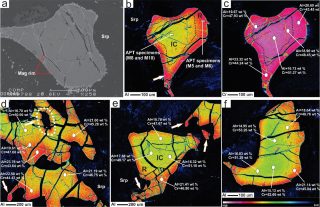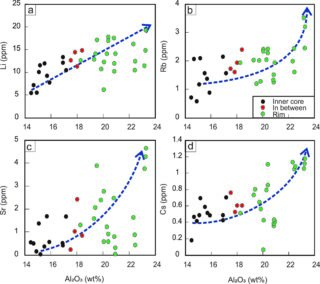Cr-spinel records metasomatism not petrogenesis of mantle rocks
Mantle melts provide a window into the processes related to global plate tectonics. The composition of chromium spinel (Cr-spinel) from mafic-ultramafic rocks has been widely used for tracing the geotectonic environments that generate mantle melts, for estimating the degree of mantle melting, and for evaluating the rate of mid-ocean ridge spreading. The assumption is that Cr-spinel’s core composition (Cr# = Cr/(Cr + Al)) is homogeneous, insensitive to post-formation modification, and therefore a robust petrogenetic indicator.
However, this widely used, and supposedly sharp tool for mantle petrology may be nowhere near as sharp as people believed it to be. That is because mantle peridotite samples generally experience complex metasomatic and metamorphic processes that can potentially obliterate their primary residual origin and cause chemical zonation/heterogeneity of Cr-spinel’s composition.

In a recently published paper in Nature Communications, PhD student Hamed Gamal El Dien and members of the Earth Dynamics Research Group use the results of a detailed microanalysis, ranging from the grain-scale to the nano-scale through X-ray elemental mapping, electron microprobe (EMP), laser-ablation inductively coupled plasma mass spectrometry (LA-ICPMS), electron backscatter diffraction (EBSD), and atom probe tomography (APT), to decipher the previously largely overlooked Cr-spinel chemical zonation/heterogeneity. The study, based on mantle peridotites from the Arabian Nubian Shield and a thorough review of previously reported global Cr-spinel results, demonstrates that the composition of Cr-spinel can be modified by fluid/melt-rock interactions in both sub-arc and sub-mid-oceanic mantle. Metasomatism can produce Al-Cr heterogeneity in Cr-spinel that lowers the Cr/Al ratio (Figure 1), and therefore modifies the Cr#, making Cr# ineffective as a geotectonic and mantle melting indicator. On the other hand, the work demonstrates that Cr-spinel is a potential sink for fluid-mobile elements, especially in subduction zone environments (Figure 2). The heterogeneity of Cr# in Cr-spinel can, therefore, be used as an excellent tracer for metasomatic processes instead.

These findings have numerous implications and future applications. It shows that we have to re-evaluate some of the previous scientific findings that assumed a homogenous and primary composition of Cr-spinel. Also, we can now use Cr-spinel composition as a melt-rock interaction indicator, and also as a tracer of mantle heterogeneity. In addition, Cr-spinel as a FME (Fluid mobile element) carrying mineral may also provide a feeding mechanism for FME’s chemical cycling into the deep mantle because Cr-spinel only breaks down at >1000 km depth. The present findings will thus potentially lead to the development of a new way of deciphering deep mantle metasomatism and heterogeneity through analysing non-traditional isotopes (e.g., Li, Zn, Ti and Ni) in Cr-spinel.
Contact person: Hamed Gamal El Dien, Earth Dynamics Research Group, Curtin University.
Relevant publication:
Hamed Gamal El Dien, Shoji Arai, Luc-Serge Doucet, Zheng-Xiang Li, Youngwoo Kil, Denis Fougerouse, Steven M. Reddy, David W. Saxey, Mohamed Hamdy. Cr-spinel records metasomatism not petrogenesis of mantle rocks. Nature Communications, Volume 10, Article number: 5103 (2019).; https://doi.org/10.1038/s41467-019-13117-1.
Read the Curtin University Media Release:
Related articles:
